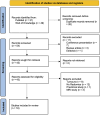Radiomics insight into the neurodegenerative " hot" brain: A narrative review from the nuclear medicine perspective
- PMID: 39355054
- PMCID: PMC11440921
- DOI: 10.3389/fnume.2023.1143256
Radiomics insight into the neurodegenerative " hot" brain: A narrative review from the nuclear medicine perspective
Abstract
The application of radiomics for non-oncologic diseases is currently emerging. Despite its relative infancy state, the evidence highlights the potential of radiomics approaches to serve as neuroimaging biomarkers in the field of the neurodegenerative brain. This systematic review presents the last progress and potential application of radiomics in the field of neurodegenerative nuclear imaging applied to positron-emission tomography (PET) and single-photon emission computed tomography (SPECT) by focusing mainly on the two most common neurodegenerative disorders, Alzheimer's (AD) and Parkinson's disease (PD). A comprehensive review of the current literature was performed using the PubMed and Web of Science databases up to November 2022. The final collection of eighteen relevant publications was grouped as AD-related and PD-related. The main efforts in the field of AD dealt with radiomics-based early diagnosis of preclinical AD and the prediction of MCI to AD conversion, meanwhile, in the setting of PD, the radiomics techniques have been used in the attempt to improve the assessment of PD diagnosis, the differential diagnosis between PD and other parkinsonism, severity assessment, and outcome prediction. Although limited evidence with relatively small cohort studies, it seems that radiomics-based analysis using nuclear medicine tools, mainly [18F]Fluorodeoxyglucose (FDG) and β-amyloid (Aβ) PET, and dopamine transporter (DAT) SPECT, can be used for computer-aided diagnoses in AD-continuum and parkinsonian disorders. Combining nuclear radiomics analysis with clinical factors and introducing a multimodality approach can significantly improve classification and prediction efficiency in neurodegenerative disorders.
Keywords: Alzheimer’s disease (AD); Parkinson’s disease (PD); neurodegenerative disease; nuclear medicine; radiomics.
© 2023 Aghakhanyan, Di Salle, Fanni, Francischello, Cioni, Cosottini, Volterrani and Neri.
Conflict of interest statement
The authors declare that the research was conducted in the absence of any commercial or financial relationships that could be construed as a potential conflict of interest.
References
Publication types
LinkOut - more resources
Full Text Sources


